Grain Refinement Effect on the Hot-Tearing Resistance of Higher-Temperature Al–Cu–Mn–Zr Alloys
Abstract
1. Introduction
2. Alloy Selection and Grain Refining
3. Casting Procedures and Microstructure Characterization
Microstructure Characterization for the DA2 Alloy
4. Hot-Tearing Characterization
- For the 206 alloy, M exhibited a larger decrease from the non-grain-refined condition to that with 0.02 wt.% Ti additions than that from Ti additions of 0.02 to 0.1 wt.%.
- For the DA1 alloy, M increased slightly with grain refinement.
- For the DA2 alloy, M is initally unchanged with 0.02 wt.% Ti addition from the non-grain-refined casting. Then, M decreased with grain refinement with a minimum of HTI observed at 0.1 wt.% Ti addition.
- For the DA5 alloy, M decreased with grain refinement, exhibiting a minimum M at 0.1 wt.% Ti addition. Unlike DA1 and DA2, M showed a decrease between the non-grain-refined casting and the alloy with 0.02 wt.% Ti addition, a decrease that was similar in magnitude to that for the 206 alloy.
- For the DA6 alloy, M showed the highest value among all of the DA alloys considered. The M variation with the amount of wt.% Ti addition resembles that for DA1, although at high values. The striking difference between the M values for the DA5 and DA7 alloys is solely due to a higher amount of Fe and Si impurities in the DA6 alloy than those in the DA7 alloy.
- For DA7 alloy, M is the smallest among all of the DA alloys. M exhibited a significant decrease between the non-grain-refined casting and the alloy with 0.02 wt.% Ti addition.
- The minimum M is observed at 0.1 wt.% Ti addition for each of the most hot-tearing-resistant alloys (DA2, DA5, and DA7).
5. Discussions
6. Conclusions
- Grain refining for the DA1 alloy (4.95 wt.% Cu) was inefective, as M was slightly higher for all grain-refined conditions as compared to its non-refined condition.
- The hot-tearing resistance was highest for the DA7 alloy (with the highest Cu level at 8 wt.%), followed by the DA5 alloy (7.3 wt.% Cu). The hot-tearing resistance significantly increased with 0.02 wt.% Ti addition (from the non-grain-refined condition).
- The best hot-tearing resistance was observed at 0.1 wt.% Ti addition for the most hot-tearing-resistant alloys (DA2, DA5, and DA7). This finding is expected based on grain size analysis, as hot-tearing resistance increases with smaller grain size and the metallography observations indicate that the finest grain size was attained at 0.1 wt.% Ti.
- It was found that the optimum wt.% Ti of 0.1 for ACMZ alloys is within the range recommended for the low impurity and low Ti levels for the 206 alloy but larger than that recommended for the A206 and B206 alloys.
Author Contributions
Funding
Acknowledgments
Conflicts of Interest
Notice
References
- Shyam, A.; Roy, S.; Shin, D.; Poplawsky, J.D.; Allard, L.F.; Yamamoto, Y.; Morris, J.R.; Mazumder, B.; Idrobo, J.C.; Rodriguez, A.; et al. Elevated temperature microstructural stability in cast AlCuMnZr alloys through solute segregation. Mater. Sci. Eng. A 2019, 765, 138279. [Google Scholar] [CrossRef]
- Sabau, A.S.; Mirmiran, S.; Glaspie, C.; Li, S.; Apelian, D.; Shyam, A.; Allen Haynes, J.; Rodriguez, A.F. Hot-Tearing Assessment of Multicomponent Nongrain-Refined Al-Cu Alloys for Permanent Mold Castings Based on Load Measurements in a Constrained Mold. Metall. Mater. Trans. B 2018, 49, 1267–1287. [Google Scholar] [CrossRef]
- Campbell, J. Castings; Butterworth and Heineman, Ltd.: Oxford, UK, 1991. [Google Scholar]
- Campbell, J.; Clyne, T. Hot tearing in Al-Cu alloys. Cast Met. 1990, 3, 224–226. [Google Scholar] [CrossRef]
- Rappaz, M.; Drezet, J.M.; Gremaud, M. A new hot-tearing criterion. Mater. Sci. Eng. A Sci. 1999, 30, 449–455. [Google Scholar] [CrossRef]
- Warrington, D.; McCartney, D. Development of a new hot-cracking test for aluminium alloys. Cast Met. 1989, 2, 134–143. [Google Scholar] [CrossRef]
- Clyne, T.W. Solidification Cracking of Aluminium Alloys. Ph.D. Thesis, University of Cambridge, Cambridge, UK, 1976. [Google Scholar]
- Spittle, J.; Cushway, A. Influences of superheat and grain structure on hot-tearing susceptibilities of AI-Cu alloy castings. Met. Technol. 1983, 10, 6–13. [Google Scholar] [CrossRef]
- Sigworth, G.K.; DeHart, F. Recent developments in the high strength aluminum-copper casting alloy A206. AFS Trans. 2003, 111, 341–354. [Google Scholar]
- Lin, S.; Aliravci, C.; Pekguleryuz, N.I.O. Hot-tear susceptibility of aluminum wrought alloys and the effect of grain refining. Mater. Sci. Eng. A Sci. 2007, 38A, 1056–1068. [Google Scholar] [CrossRef]
- Rosenberg, R.A.; Flemings, M.C.; Taylor, H.F. Nonferrous Binary Alloys Hot Tearing. AFS Trans. 1960, 58, 518–528. [Google Scholar]
- Davidson, C.; Viano, D.; Lu, L.; StJohn, D. Observation of crack initiation during hot tearing. Int. J. Cast Met. Res. 2006, 19, 59–65. [Google Scholar] [CrossRef]
- Mathier, V.; Grasso, P.D.; Rappaz, M. A new tensile test for aluminum alloys in the mushy state: Experimental method and numerical modeling. Mater. Sci. Eng. A Sci. 2008, 39A, 1399–1409. [Google Scholar] [CrossRef][Green Version]
- Rosenberg, R.; Flemings, M.; Taylor, H. Nonferrous binary alloys hot tearing. AFS Trans 1960, 69, 518–528. [Google Scholar]
- Li, S.; Sadayappan, K.; Apelian, D. Characterisation of hot tearing in Al cast alloys: Methodology and procedures. Int. J. Cast Met. Res. 2011, 24, 88–95. [Google Scholar] [CrossRef]
- Shower, P.; Roy, S.; Hawkins, C.S.; Shyam, A. The effects of microstructural stability on the compressive response of two cast aluminum alloys up to 300 °C. Mater. Sci. Eng. A 2017, 700, 519–529. [Google Scholar] [CrossRef]
- Shower, P.; Morris, J.; Shin, D.; Radhakrishnan, B.; Poplawsky, J.; Shyam, A. Mechanisms for stabilizing θ′(Al2Cu) precipitates at elevated temperatures investigated with Phase Field modeling. Materialia 2019, 6, 100335. [Google Scholar] [CrossRef]
- Shower, P.; Morris, J.R.; Shin, D.; Radhakrishnan, B.; Allard, L.F.; Shyam, A. Temperature-dependent stability of θ′-Al2Cu precipitates investigated with phase field simulations and experiments. Materialia 2019, 5, 100185. [Google Scholar] [CrossRef]
- Bahl, S.; Hu, X.; Hoar, E.; Cheng, J.; Haynes, J.A.; Shyam, A. Effect of copper content on the tensile elongation of Al–Cu–Mn–Zr alloys: Experiments and finite element simulations. Mater. Sci. Eng. A 2020, 772, 138801. [Google Scholar] [CrossRef]
- Milligan, B.K.; Roy, S.; Hawkins, C.S.; Allard, L.F.; Shyam, A. Impact of microstructural stability on the creep behavior of cast Al–Cu alloys. Mater. Sci. Eng. A 2020, 772, 138697. [Google Scholar] [CrossRef]
- Sigworth, G. Grain refining of aluminum casting alloys. In Proceedings of the Sixth International AFS Conference on Melt Treatment of Aluminum, Orlando, FL, USA, 11–13 November 2001; pp. 210–221. [Google Scholar]
- Greer, A.L.; Cooper, P.S.; Meredith, M.W.; Schneider, W.; Schumacher, P.; Spittle, J.A.; Tronche, A. Grain refinement of aluminium alloys by inoculation. Adv. Eng. Mater. 2003, 5, 81–91. [Google Scholar] [CrossRef]
- Greer, A. Grain refinement of alloys by inoculation of melts. Philos. Trans. R. Soc. London, Ser. A 2003, 361, 479–495. [Google Scholar] [CrossRef]
- Pumphrey, W.I.; Lyons, J.V. Cracking during the casting and welding of the more common binary aluminium alloys. J. Inst. Met. 1948, 74, 439. [Google Scholar]
- Easton, M.; Wang, H.; Grandfield, J.; St John, D.; Sweet, E. An analysis of the effect of grain refinement on the hot tearing of aluminium alloys. Mater. Sci. Forum. 2004, 28, 224–229. [Google Scholar]
- Warrington, D.; McCartney, D. Hot-cracking in aluminium alloys 7050 and 7010-a comparative study. Cast Met. 1990, 3, 202–208. [Google Scholar] [CrossRef]
- Li, S.; Sadayappan, K.; Apelian, D. Role of grain refinement in the hot tearing of cast Al-Cu alloy. Metall. Mater. Trans. B 2013, 44, 614–623. [Google Scholar] [CrossRef]
- Spittle, J.A. Grain refinement in shape casting of aluminium alloys. Int. J. Cast Met. Res. 2006, 19, 210–222. [Google Scholar] [CrossRef]
- Metz, S.A.; Flemings, M.C. Fundamental study of hot tearing. Trans. Am. Foundrymen’s Soc. 1970, 78, 453. [Google Scholar]
- Dahle, A.; Arnberg, L. Development of strength in solidifying aluminium alloys. Acta Mater. 1997, 45, 547–559. [Google Scholar] [CrossRef]
- Fasoyinu, Y. Energy Saving Melting and Revert Reduction Technology (Energy-SMARRT): Light Metals Permanent Mold Casting; Technical Report for U.S. Department of Energy Office of Scientific and Technical Information: Oak Ridge, TN, USA, 2014. [Google Scholar] [CrossRef]
- Properties and Selection of Aluminum Alloys; Kevin, A., John, W., Kaufman, J.G., Eds.; ASM International: Geauga, OH, USA, 2019; Volume 2B. [Google Scholar] [CrossRef]
- Kamga, H.K.; Larouche, D.; Bournane, M.; Rahem, A. Hot tearing of aluminum-copper B206 alloys with iron and silicon additions. Mater. Sci. Eng. A 2010, 527, 7413–7423. [Google Scholar] [CrossRef]
- D’Elia, F.; Ravindran, C. 09-055 Effect of Ti-B Grain Refiner on Hot Tearing in Permanent Mold Cast B206 Aluminum Alloy. Trans. Am. Foundrymen’s Soc. 2009, 117, 139. [Google Scholar]
- Chadwick, H. Hot Shortness of Al 4.5% Cu Alloy. Cast Met. 1991, 4, 43–49. [Google Scholar] [CrossRef]
- Sigworth, G.K.; Kuhn, T.A. Grain refinement of aluminum casting alloys. Int. J. Metalcast. 2007, 1, 31–40. [Google Scholar] [CrossRef]
- Easton, M.; Qian, M.; Prasad, A.; StJohn, D. Recent advances in grain refinement of light metals and alloys. Curr. Opin. Solid State Mater. Sci. 2016, 20, 13–24. [Google Scholar] [CrossRef]
- ASTM E-1382 T. Standard Test Methods for Determining Average Gran Size Using Semiautomatic and Automatic Image Analysis; ASTM International: Philadelphia, PA, USA, 1997; Volume 3.01, pp. 901–922. [Google Scholar]
- Roy, S.; Allard, L.; Rodriguez, A.; Watkins, T.; Shyam, A. Comparative Evaluation of Cast Aluminum Alloys for Automotive Cylinder Heads: Part I-Microstructure Evolution. Metall. Mater. Trans. A 2017, 48A, 2529–2542. [Google Scholar] [CrossRef]
- Porter, D.; Easterling, K. Precipitation in Age Hardening Alloys. In Phase Transformations in Metals and Alloys, 2nd ed.; Chapman and Hall: London, UK, 1992. [Google Scholar]
- Unwin, P.N.T.; Lorimer, G.W.; Nicholson, R.B. The origin of the grain boundary precipitate free zone. Acta Metall. 1969, 17, 1363–1377. [Google Scholar] [CrossRef]
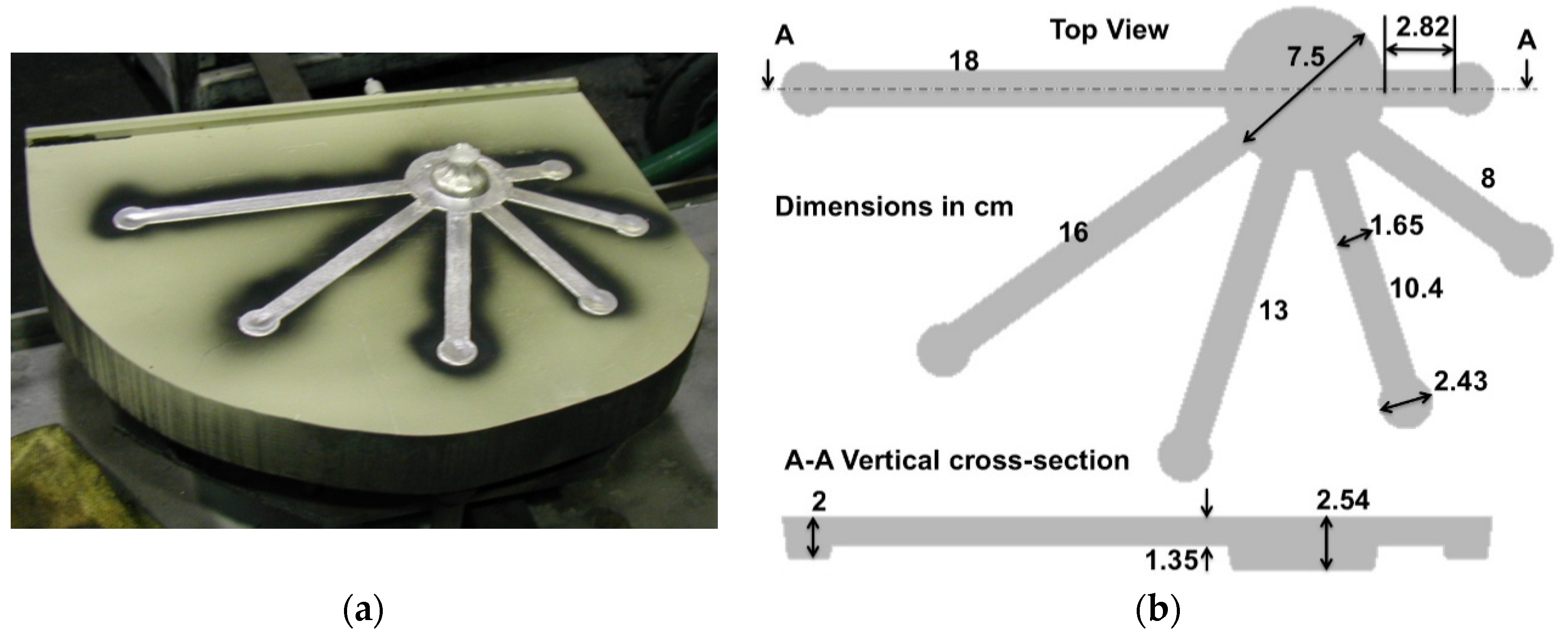
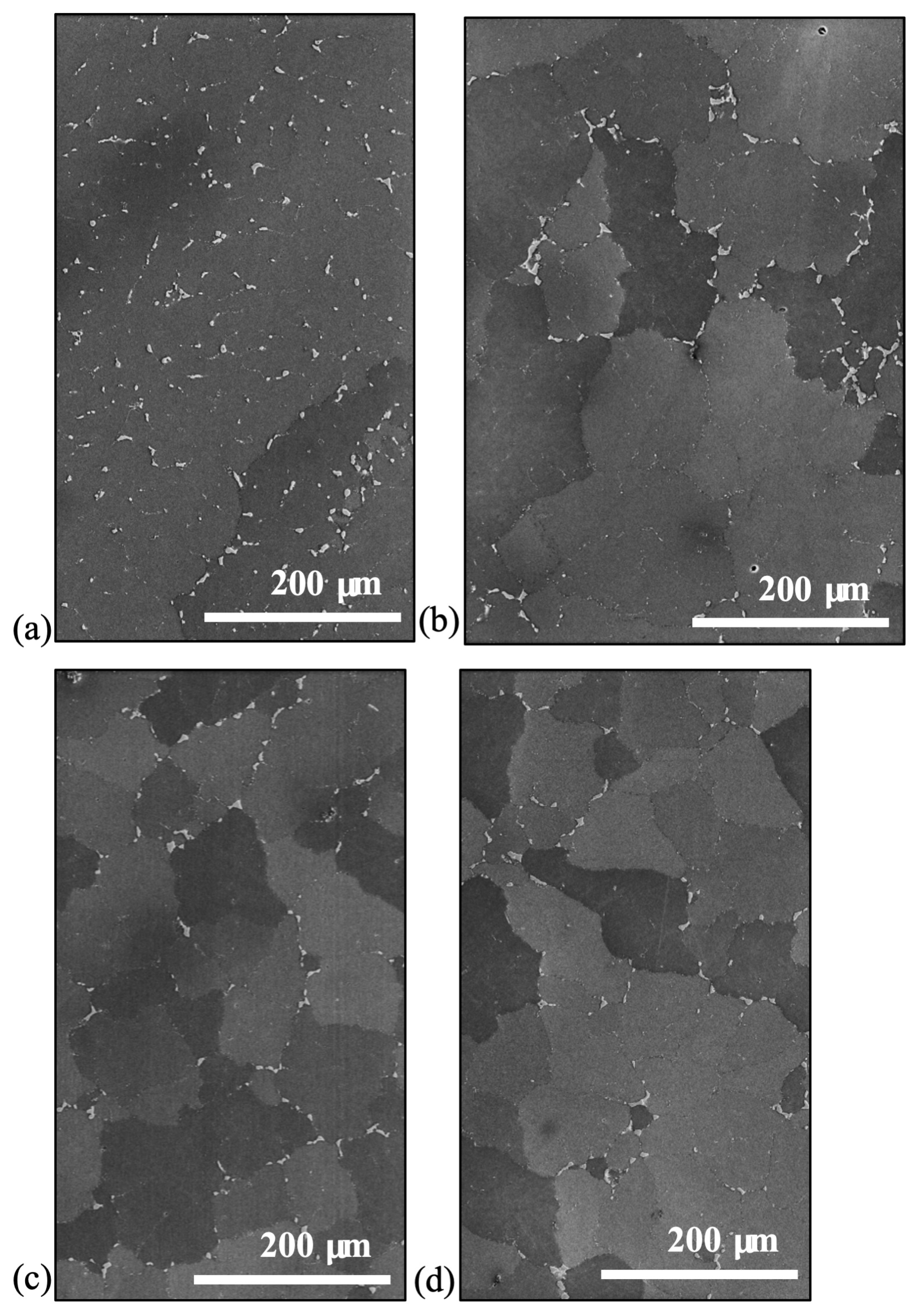
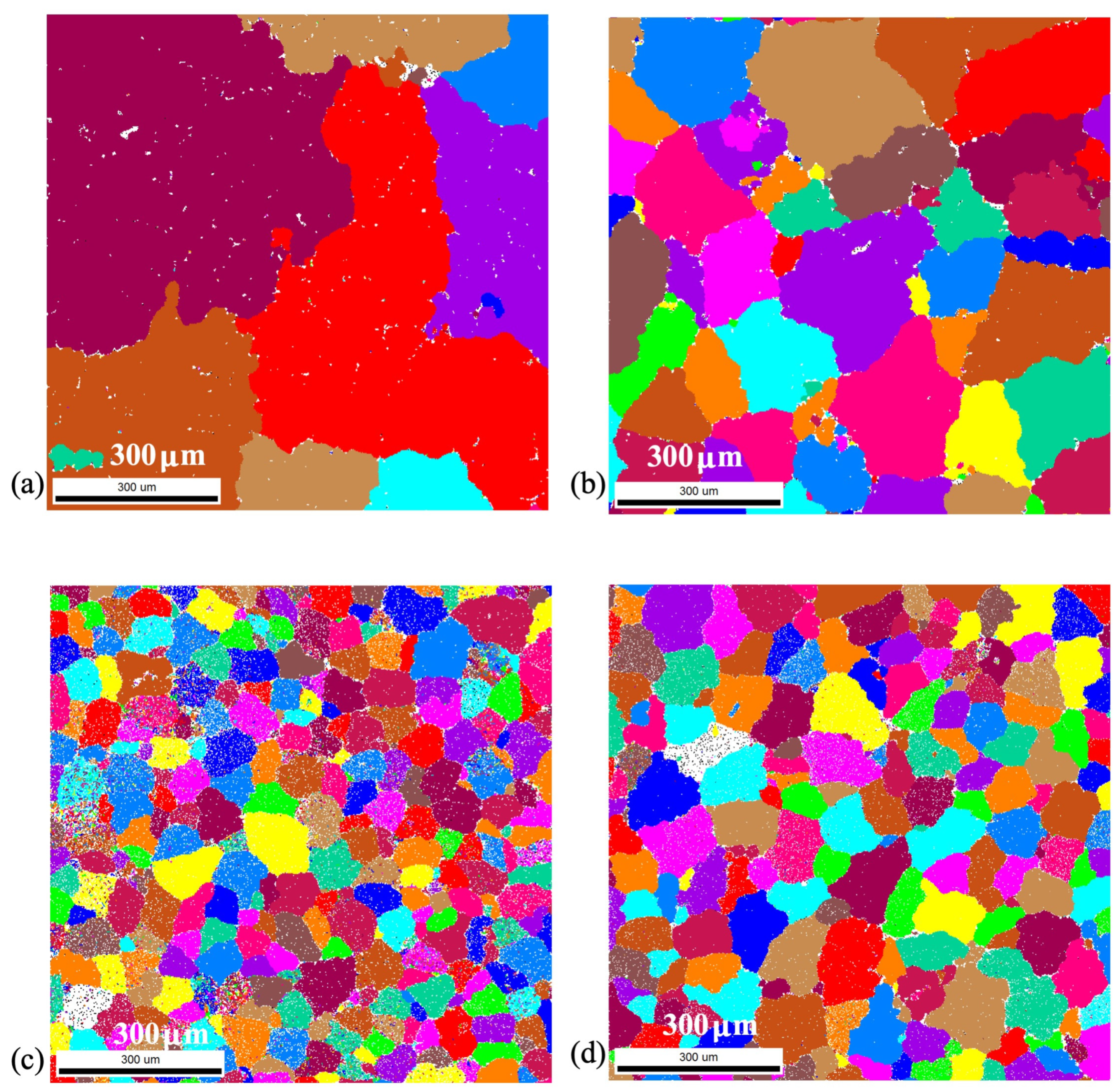
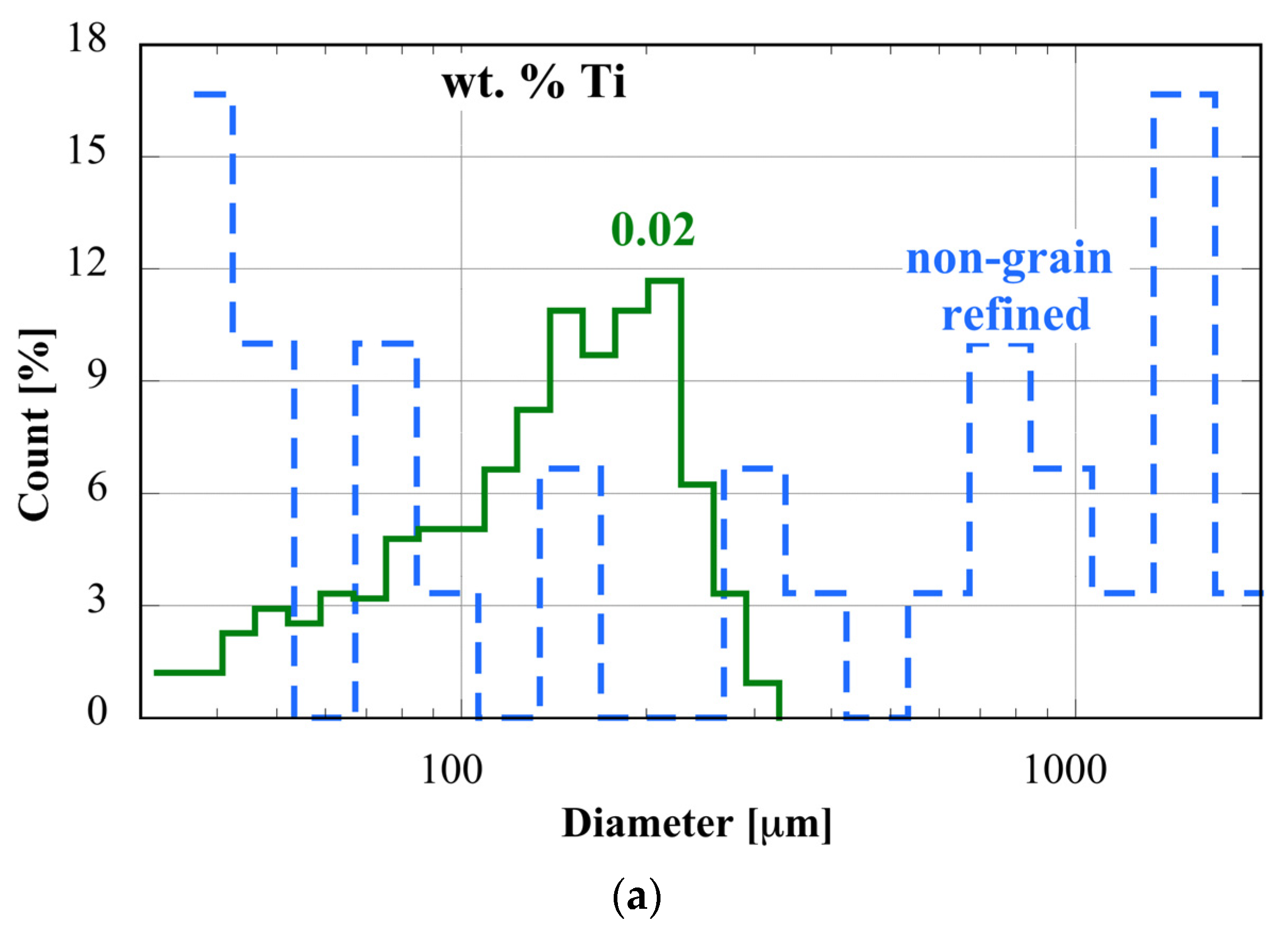
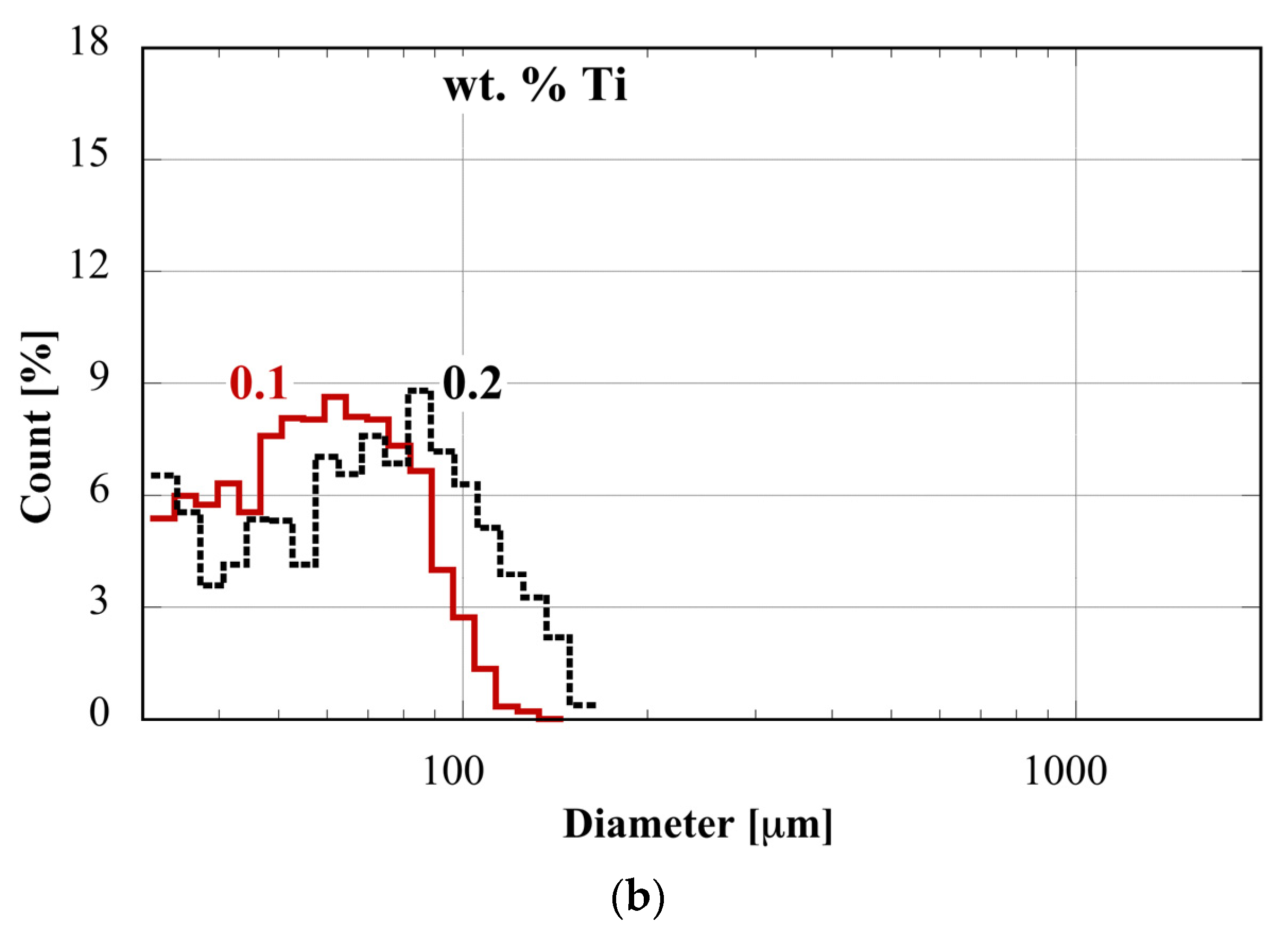
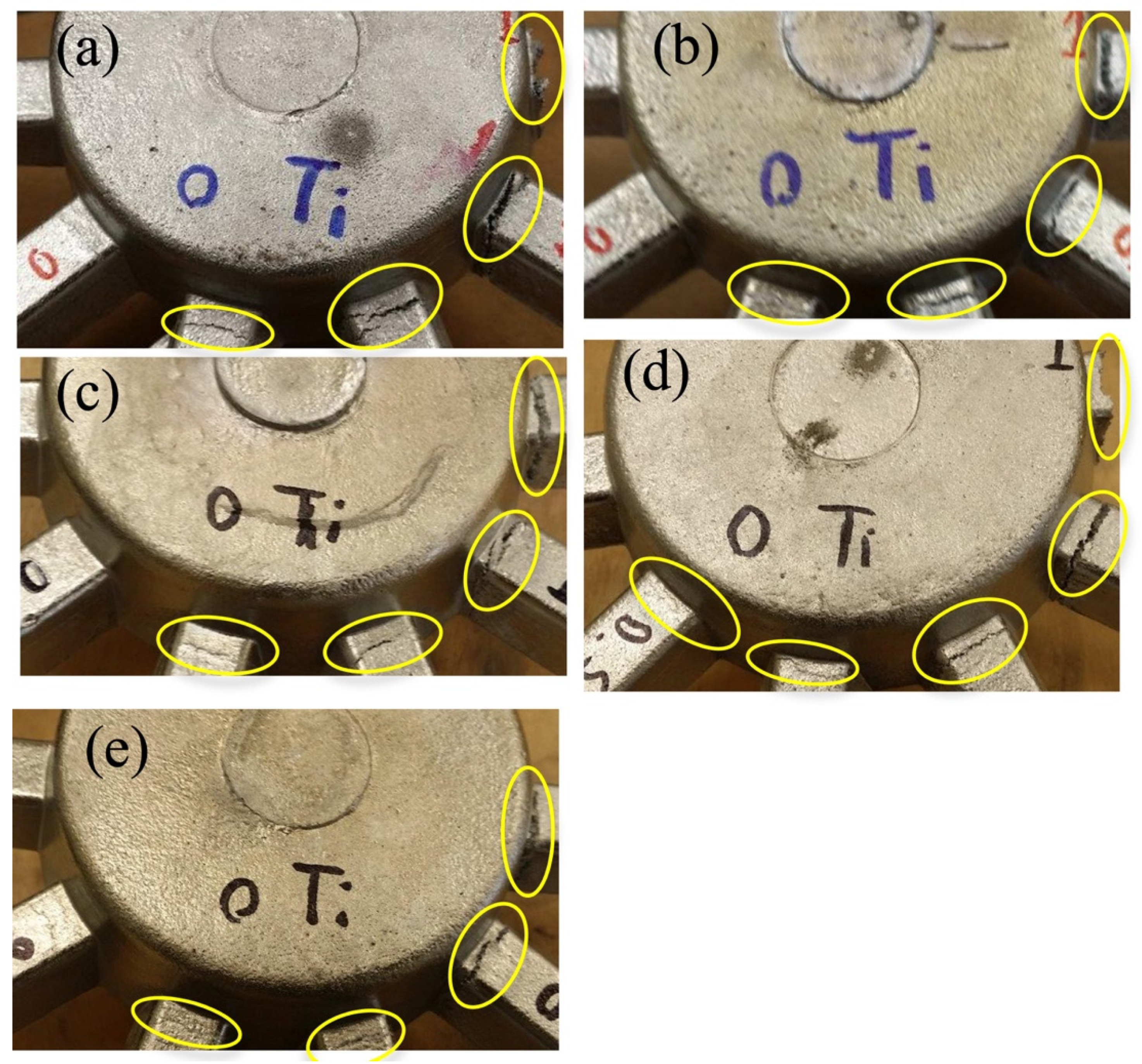
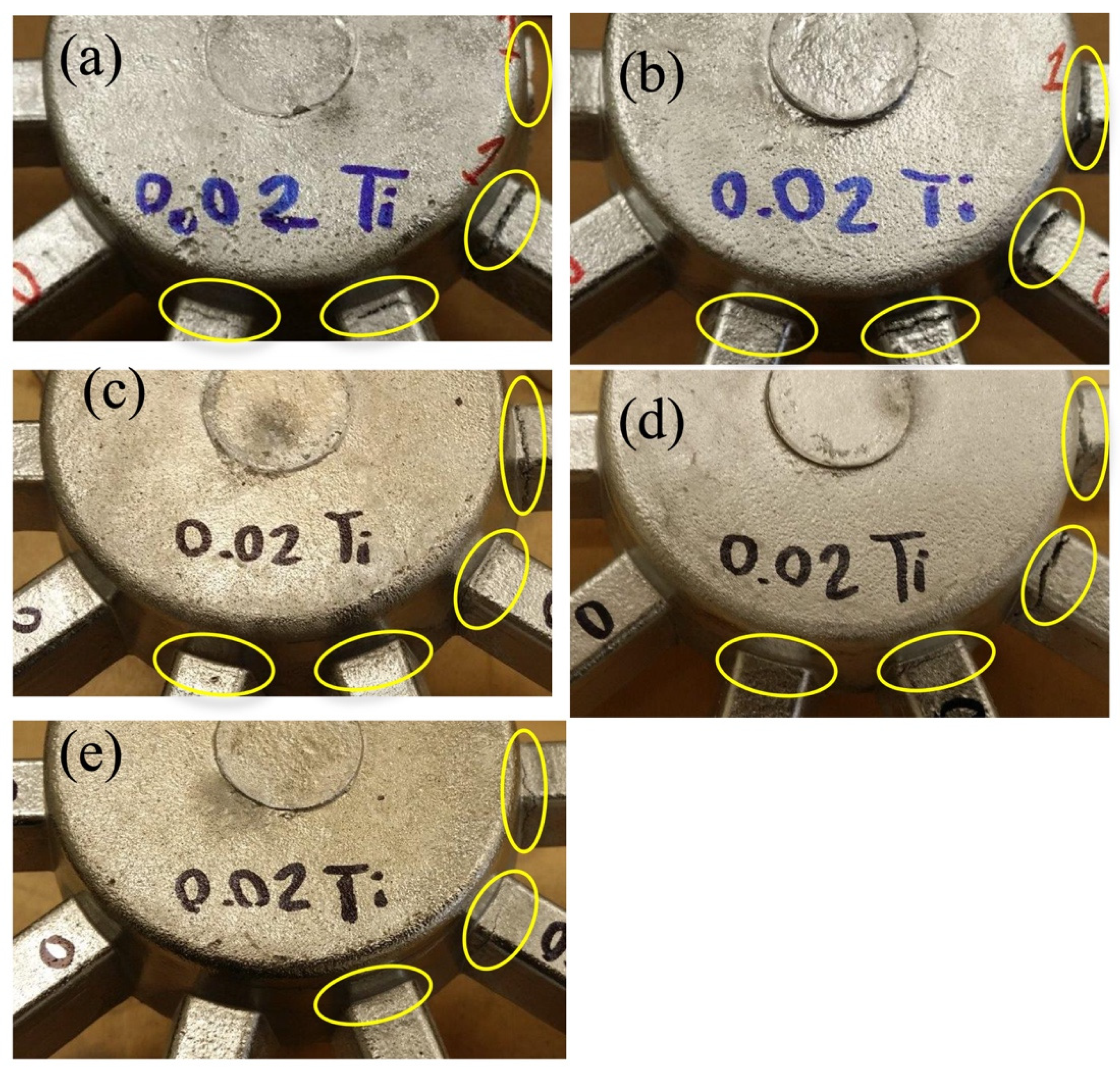
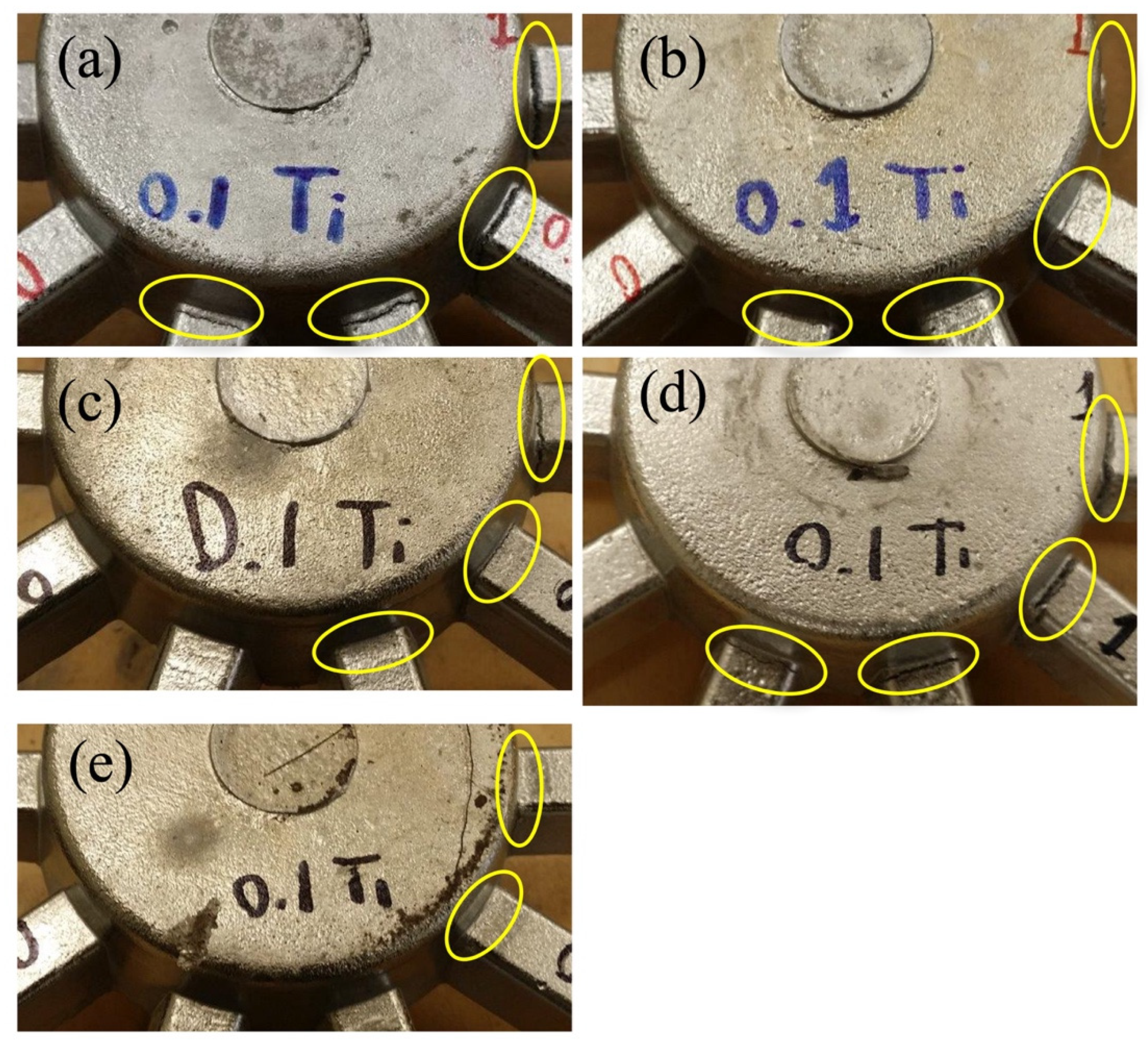

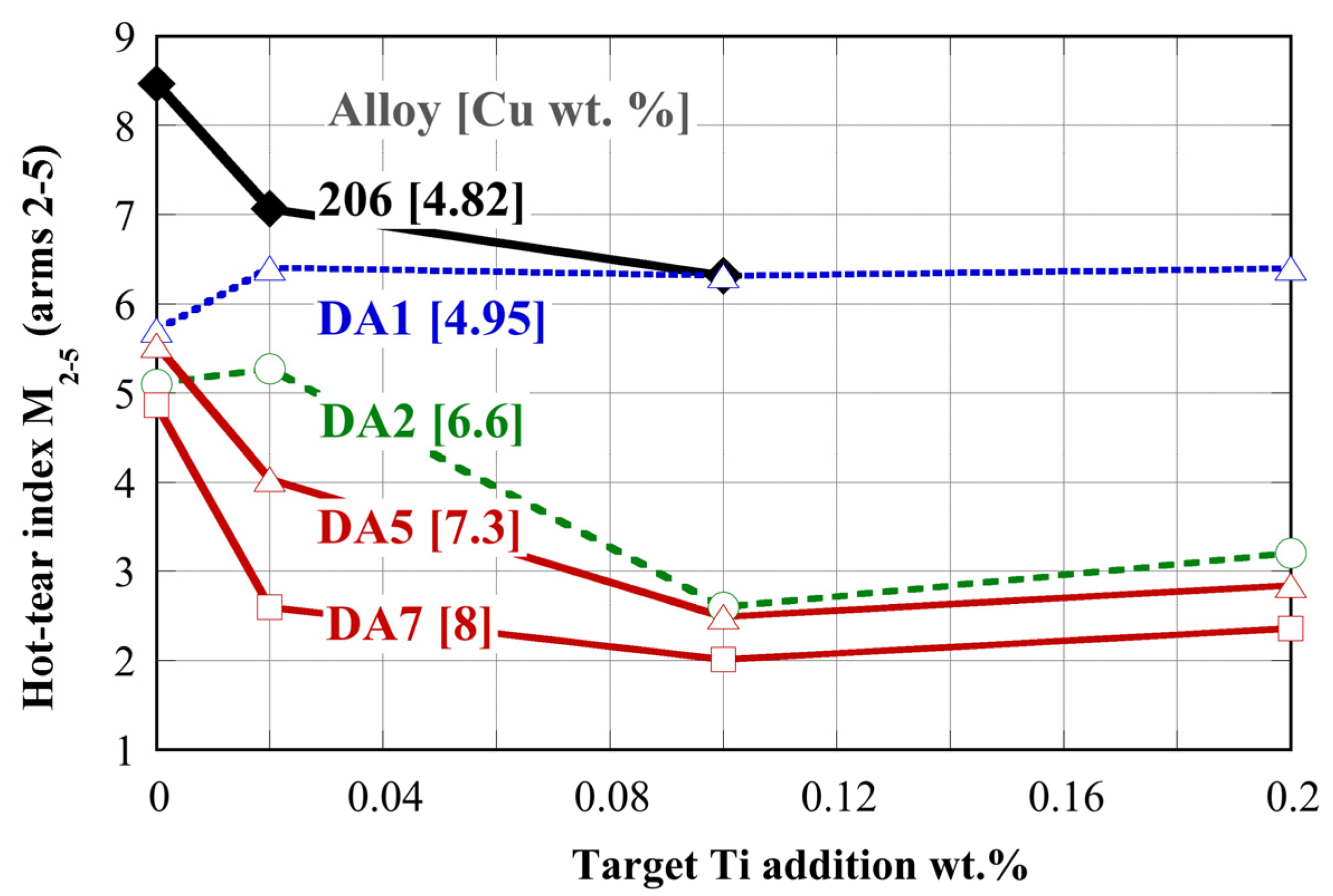
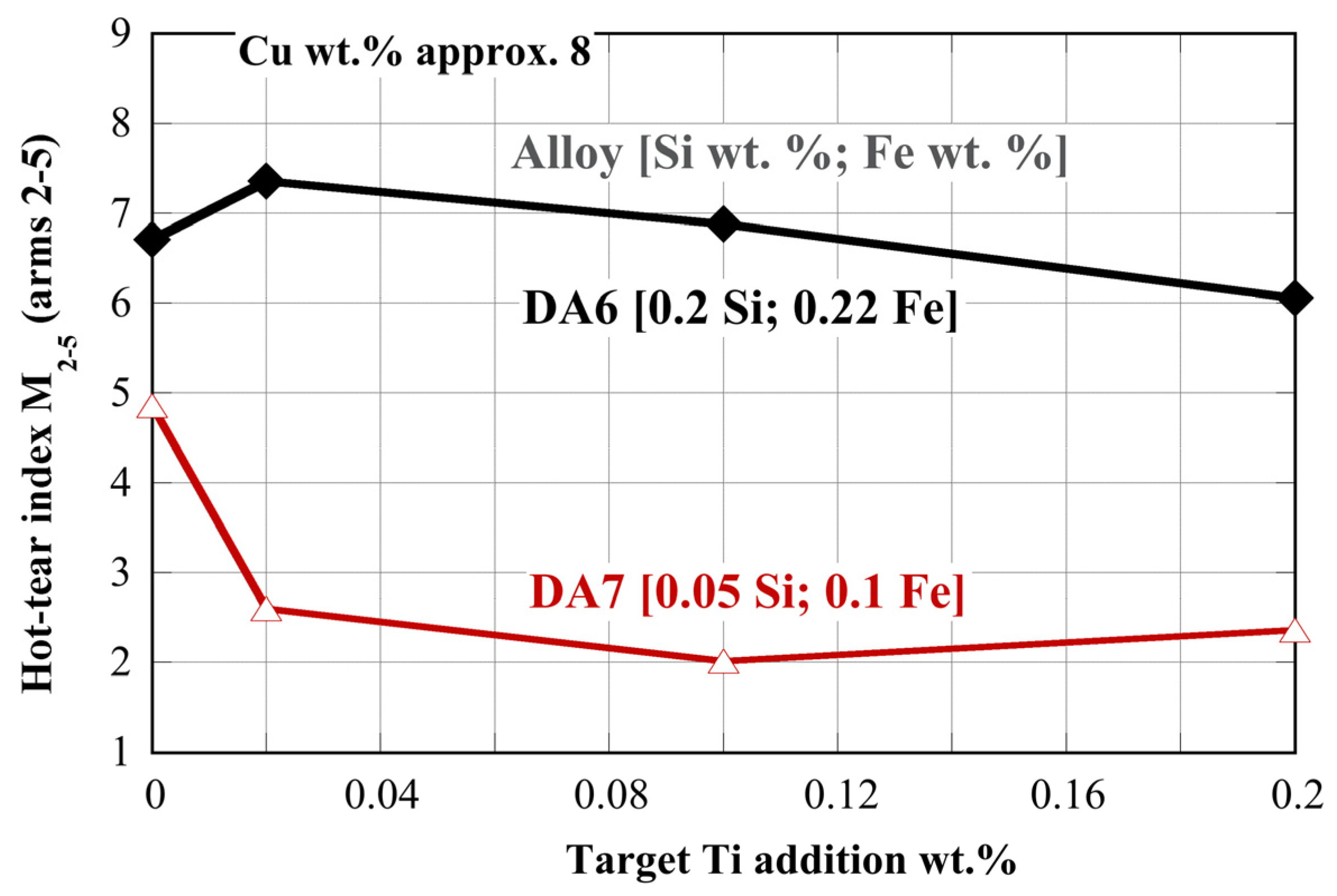
| Alloy | Cu wt. [%] | Mn wt. [%] | Zr wt. [%] | Si wt. [%] | Fe wt. [%] | Mg wt. [%] | Ni wt. [%] |
|---|---|---|---|---|---|---|---|
| 206 | 4.82 | 0.254 | 0.004 | 0.041 | 0.095 | 0.274 | 0.0065 |
| DA1 | 4.95 | 0.106 | 0.147 | 0.051 | 0.1 | 0.0026 | 0.163 |
| DA2 | 6.214 | 0.448 | 0.191 | 0.0587 | 0.0952 | ||
| DA5 | 7.316 | 0.441 | 0.168 | 0.0501 | 0.0983 | ||
| DA6 | 8.211 | 0.44 | 0.207 | 0.202 | 0.219 | ||
| DA7 | 8.01 | 0.451 | 0.187 | 0.0488 | 0.102 |
| Ti wt.% | Median Grain Size (µm) | Intermetallic Area Fraction | Intermetallic Number Density (1/µm2) | Intermetallic Average Area (µm2) |
|---|---|---|---|---|
| 0 | 525.6 | 0.0171 | 0.00141 | 12 |
| 0.02 | 137.2 | 0.0119 | 0.00094 | 13 |
| 0.1 | 57.8 | 0.0137 | 0.00087 | 18 |
| 0.2 | 70.1 | 0.0122 | 0.00098 | 12 |
| Ci | Crack Description |
|---|---|
| 0 | No cracks |
| 2.5 | Small crack |
| 5 | Moderate crack |
| 7.5 | Severe crack |
| 10 | Arm fractured |
| Alloy (Cu wt.%) | * Ti wt.% | MS | M2–5 |
|---|---|---|---|
| 206 (4.82) | 0 | 7.5 | 8.47 |
| 0.02 | 6.67 | 7.07 | |
| 0.1 | 6.17 | 6.31 | |
| DA1 (4.95) | 0 | 5.9 | 5.71 |
| 0.02 | 6.25 | 6.4 | |
| 0.1 | 6.16 | 6.31 | |
| 0.2 | 6.25 | 6.4 | |
| DA2 (6.2) | 0 | 5.4 | 5.1 |
| 0.02 | 5.5 | 5.27 | |
| 0.1 | 3.42 | 2.6 | |
| 0.2 | 4.25 | 3.21 | |
| DA5 (7.3) | 0 | 5.8 | 5.53 |
| 0.02 | 4.25 | 4.03 | |
| 0.1 | 3.25 | 2.49 | |
| 0.2 | 3.42 | 2.84 | |
| DA6 (8.2) | 0 | 6.5 | 6.71 |
| 0.02 | 6.9 | 7.36 | |
| 0.1 | 6.6 | 6.88 | |
| 0.2 | 6.1 | 6.05 | |
| DA7 (8) | 0 | 5.1 | 4.86 |
| 0.02 | 3.33 | 2.6 | |
| 0.1 | 2.5 | 2.01 | |
| 0.2 | 2.75 | 2.36 |
| Alloy | Ti wt.% | Median Grain Size (µm) | M2–5 |
|---|---|---|---|
| DA2 | 0 | 525.6 | 5.1 |
| 0.02 | 137.2 | 5.27 | |
| 0.1 | 57.8 | 2.6 | |
| 0.2 | 70.1 | 3.21 |
| Alloy | wt.% Fe and wt.% Si | * wt.% Ti | Reference | Addition Max Ti wt.% | Notes |
|---|---|---|---|---|---|
| 206 | 0.12 and 0.06 | 0.24 | [9] | specified per ladle | grain refining not affecting hot tearing |
| 206 | 0.05 and 0.05 | 0.006 | [27] | 0.15 | optimum 0.1–0.15 wt.% Ti |
| A206 | 0.1 and 0.05 | 0.15–0.25 | [9] | 0.05 | recommend ≤0.05 wt.% Ti |
| B206 | 0.06 and 0.1 | 0.01 | [33] | 0.05 | recommend [0.02:0.05] wt.% Ti range |
| ACMZ | 0.07 and 0.08 | 0.06 | This study | 0.2 | optimum 0.1 wt.% Ti |
© 2020 by the authors. Licensee MDPI, Basel, Switzerland. This article is an open access article distributed under the terms and conditions of the Creative Commons Attribution (CC BY) license (http://creativecommons.org/licenses/by/4.0/).
Share and Cite
Sabau, A.S.; Milligan, B.K.; Mirmiran, S.; Glaspie, C.; Shyam, A.; Haynes, J.A.; Rodriguez, A.F.; Gonzalez Villarreal, J.A.; Talamantes, J. Grain Refinement Effect on the Hot-Tearing Resistance of Higher-Temperature Al–Cu–Mn–Zr Alloys. Metals 2020, 10, 430. https://doi.org/10.3390/met10040430
Sabau AS, Milligan BK, Mirmiran S, Glaspie C, Shyam A, Haynes JA, Rodriguez AF, Gonzalez Villarreal JA, Talamantes J. Grain Refinement Effect on the Hot-Tearing Resistance of Higher-Temperature Al–Cu–Mn–Zr Alloys. Metals. 2020; 10(4):430. https://doi.org/10.3390/met10040430
Chicago/Turabian StyleSabau, Adrian S., Brian K. Milligan, Seyed Mirmiran, Christopher Glaspie, Amit Shyam, J. Allen Haynes, Andres F. Rodriguez, J.A. Gonzalez Villarreal, and Jose Talamantes. 2020. "Grain Refinement Effect on the Hot-Tearing Resistance of Higher-Temperature Al–Cu–Mn–Zr Alloys" Metals 10, no. 4: 430. https://doi.org/10.3390/met10040430
APA StyleSabau, A. S., Milligan, B. K., Mirmiran, S., Glaspie, C., Shyam, A., Haynes, J. A., Rodriguez, A. F., Gonzalez Villarreal, J. A., & Talamantes, J. (2020). Grain Refinement Effect on the Hot-Tearing Resistance of Higher-Temperature Al–Cu–Mn–Zr Alloys. Metals, 10(4), 430. https://doi.org/10.3390/met10040430






